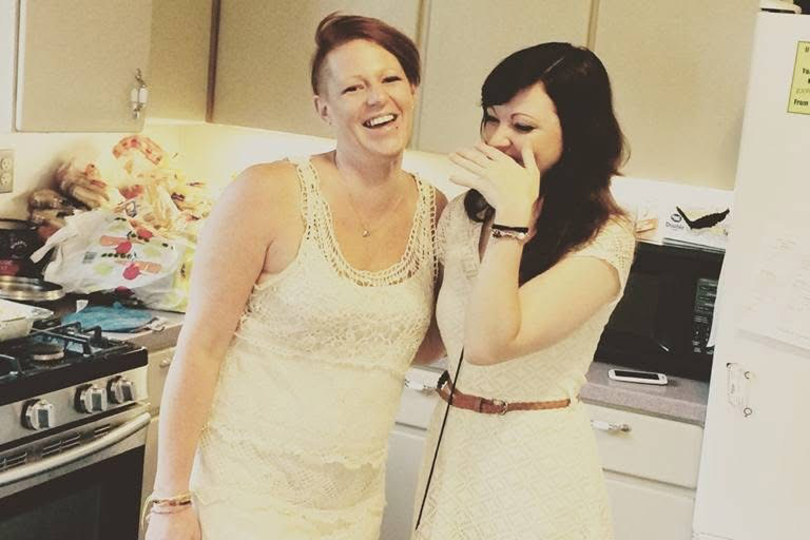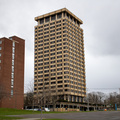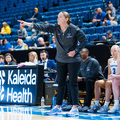Julianne Thomas applies community-based addiction prevention with CRPRC

Growing up, drugs and alcohol allowed Julianne Thomas to feel like a "normal person." Today, Thomas provides community-based substance use training and technical assistance to all 13 central New York counties. Courtsey of Julianne Thomas
Get the latest Syracuse news delivered right to your inbox.
Subscribe to our newsletter here.
Julianne Thomas first drank alcohol when she was 11 years old. Growing up in what she called a “dysfunctional” family, Thomas was exposed to substances at a young age and checked herself into rehab at age 20.
Now, Thomas draws on her experience to support the central New York community. She provides substance use training and technical assistance across the region as a community development specialist at the Central Region Prevention Resource Center.
“I wanted to do something that didn’t feel so reactive, like I am preventing people from getting into these situations instead of trying to help people that are already kind of stuck in a rut,” Thomas said.
She started out as an advocate with Liberty Resources’ shelter and domestic violence programs and then began working at CRPRC in 2023. Located in Syracuse, the CRPRC works to prevent drug use by connecting people to business owners, law enforcement, hospitals and teachers’ associations.
Thomas went to the CRPRC aiming to stop addiction before it starts.
“It’s a lot different from what I was doing because it’s trying to change the stuff within a community that makes it more easier to use,” Thomas said.
Her primary responsibility is to help community members overcome their reliances on drugs and alcohol.
Emily Moore, leader of community education at Prevention Network CNY, which the CRPRC is housed under, works with Thomas in CRPRC’s Syracuse office. She and Thomas educate people on how they can avoid addiction.
“Making it clear how important it is to have a support network, how important it is to be around people that are positive, how important it is to be able to make your own choice — the importance of all of those things is really what we build upon to then get to the point where we can show some data,” Moore said.
Thomas doesn’t often mention her experience with addiction when she presents prevention information to communities, unless she’s specifically asked. Scare tactics aren’t effective in preventative education, Moore said.
Growing up, Thomas saw her mother, Lisa, and stepfather fight regularly, both physically and verbally. Her family constantly moved to and from her stepfather’s house throughout her childhood, going between Florida and central New York.
Thomas said her mother and stepfather relied on addiction and prescription pills to keep their relationship together.
“The time when things are peaceful is when both my mom and my stepdad have access to pills,” Thomas said. “It was just a curiosity of like, ‘What’s so great about this?’”
When she got older, Thomas used drugs to escape a feeling of “otherness,” she said. The more she used substances, she said, the more she felt comfortable around other people who used them.
In high school, Thomas’ on-and-off boyfriend dealt marijuana, so she started smoking it regularly. Toward her senior year, she frequently attended college house parties, where she would exchange oxycontin for cocaine and ecstasy, she said.
When her ex-boyfriend went to college, the two broke up and Thomas started dating someone who used heroin. She began to use heroin and IV drugs. From there, she met other people who were using drugs, lost her car, quit her job and rarely went outside — unless she was buying drugs.
“It was so much work just to get up and try to find drugs every day to feel okay,” Thomas said. “And to live life like that, I was just so tired. I couldn’t picture waking up another day and having to do life again.”

Courtsey of Julianne Thomas
Julianne Thomas checked herself into Dick Van Dyke Treatment Center at 20 years old to combat an addiction to drugs and alcohol. Through her work with the CRPRC, Thomas now works to shift messaging around substance addiction and prevention.
At 20 years old, Thomas woke up in her apartment, surrounded by other people who were using drugs and without drugs or money. Knowing withdrawal was inevitable, she realized she could no longer live that way.
An evaluation at a local outpatient center led Thomas to check herself into rehab. But after a week, she left due to illness. A month later, Thomas went to a different treatment center.
“At that point, I don’t care how much pain I’m in or how sick I get. I’m gonna stay this time,” Thomas said.
Compared to the first center Thomas went to, the Dick Van Dyke Addiction Treatment Center was more “intimate,” she said, with room for just six women. In her first week there, Thomas only got up for medication and food. For the other five weeks, she lived under a daily schedule of meals, support groups, one-on-one counseling sessions, time in the recreation room and walks near Seneca Lake.
Once a week, the center would bring in a local speaker from Alcoholics Anonymous to share their stories with patients. It was the first time Thomas heard about AA, which the center’s staff strongly encouraged her to attend on her own outside of rehab.
Following her rehabilitation, Thomas lived with Lisa for a week while she waited to move into a halfway house, or a community with other people newly out of rehab. Lisa’s job at Destiny Mall kept her out of the house most of the day, similar to when Thomas first started using drugs and alcohol.
But this time, Thomas “white knuckled it.” Whenever she was worried she might relapse, she walked to nearby AA meetings and confided in others.
After a week, Thomas moved into Charles Street Residence, a halfway house in Cortland with 12 other people who were experiencing drug and alcohol addiction. Eight months later, she moved to a supportive living environment in Cortland with her best friend Leah Todd, who she met at the Charles Street Residence. Catholic Charities covered all the bills and utilities for both women as Thomas checked off two years sober.
“I was still worried I might get out and just f*ck up,” Thomas said. “But, I knew that I had a different mindset at that point. I was feeling good. I was finally getting some cognition back and felt like a real person.”
Debt from her time at community college temporarily closed the door to returning to school, so Thomas worked as a waitress for her first job out of rehab.
She continued searching for a job she felt fulfilled in. That didn’t become apparent until her counselor mentioned a New York state peer specialist certification.
After seven months of online classes, Thomas began work with Liberty Resources in 2018 as a shelter advocate, with the stipulation that she finish her certification within her first six months in the role. Thomas would offer rides to meetings for those in supportive housing, talk to them about recovery and share her story with others who were committed to getting sober.
Thomas also worked on a 24-hour domestic violence crisis hotline until 2023, when the shelter program lost its grant. She said she quickly burned out from the emotional toll of reactive prevention and 3:00 a.m. crisis calls.
“They’re in terrible situations. They don’t deserve for somebody to be picking up the phone and dreading that they have to help them,” Thomas said.
While at Liberty, Thomas loved giving presentations at college campuses and knew she was a better fit for prevention education. Now, at the CRPRC, she works to change messaging around substance addiction and prevention.
“My life is completely different, but I know that I am still the same person that has a lot of those anxieties, discomfort and awkwardness,” Thomas said. “Those things are just part of who I am. Now, I have better skills that I’m equipped with to deal with that stuff rather than just drinking and using drugs.”






